| | Blue-Green Algae is the common term for a type of bacteria called cyanobacteria. Cyanobacteria are natural inhabitants of surface waters and are widely present in dugouts and reservoirs. They become a problem when conditions promote rapid growth and eventual death and decomposition. For more information on its identification the sources at the end of this document should be reviewed. You can also contact a water specialist by calling 310-FARM (3276) for help regarding identification and recommendations.
Background
Some cyanobacteria produce toxins that can make the water less palatable, cause distress or illness in livestock, pets or wildlife and in some cases cause fatality. Some species of cyanobacteria do not produce toxins; however these often occur together with toxin-producing species in dugouts. Monitoring data from Alberta suggests that more than 50% of cyanobacteria blooms are toxic, but often exceeds more than 75%. Therefore, suspected cyanobacteria blooms should initially be treated as if harmful toxins are present and a water specialist contacted immediately if used for animal consumption.
Higher levels of nutrients in the dugout can lead to more intense growth of cyanobacteria. It is recommended to limit nutrients in the dugout by implementing best management practices such as grassed waterways, buffer strips surrounding the water source, and shut off culvert controls to divert water with high nutrient loads through a bypass ditch. Manure can be a source of nutrients as well as runoff from fertilized fields, nearby trees or brush, or water that travels through peat land. Nitrogen and phosphorous are critical nutrients for their growth. Light, temperature and inorganic carbon are the other main requirements for growth. The temperature for maximal growth rate for most cyanobacteria is above 25° C which is higher than for most other growths.
Still and confined waters, such as dugouts and reservoirs with warm surface water, tend to promote development of cyanobacteria blooms. Shallower water generally results in warmer water . Many dugouts have enough nutrients to sustain the growth of cyanobacteria; however temperature is often the limiting factor. When temperature increases the occurrences of cyanobacteria also increase in general. Sometimes other algae or plants can dominate, thereby limiting the growth of cyanobacteria. Increasing the depth of the dugout and installing an aeration system will help reduce water temperature and improve water quality. Duckweed naturally provides shade and may become dominant over cyanobacteria. Dugout evaporation covers may be feasible in some cases in southern Alberta.
Optimal conditions vary from one species to another. Some species are able to survive long periods without sunlight and all have a remarkable ability to store essential nutrients. Various species can survive in fresh or salt water, oxygenated or anoxic water, and with or without dissolved organic matter. Cyanobacteria can over-winter in a dugout and once established, is likely to reappear given acceptable conditions.
The word cyan (part of the word cyanobacteria) means blue-green, but in addition to green chlorophyll, cyanobacteria contain many other accessory pigments that can influence their color and gives rise to species that appear green and blue-green but also other colors like red, purple and red-brown. The additional pigments allow them to harvest light at spectrums other phytoplankton types of growths can’t use. Cyanobacteria can outcompete other types of growths such as green algae for example in turbid water as light is less available., Cyanobacteria also outcompete algae during periods of nutrient limitation as some species can fix atmospheric nitrogen. Notably, in nitrogen enriched conditions other harmless forms of algae can outcompete cyanobacteria.
Many species of cyanobacteria can trap the gasses they produce in bubbles so as to control their buoyancy allowing them to rise or lower in the water column to optimal levels of light intensity and spectrum. During the daytime by-products of photosynthesis cause them to become heavy and thus, sink. They respire at night and feed off their reserves produced during the daytime. The need for light causes cyanobacteria to rise rapidly to the surface the following day giving the appearance of a sudden growth. This rapid appearance can also intensified by water column mixing from wind action, followed by a period of calmness. During the fall photosynthesis is relatively higher than respiration because of the colder temperature and they fall to the bottom of the dugout where they can survive the winter slowly feeding off their reserves. Over-wintering populations provide seed for the following spring and when conditions permit, cyanobacteria can become dominant once again.
Diagnosis
It is important to properly diagnose the growth in the dugout so the proper course of action can be taken. Cyanobacteria can in some instances be difficult to diagnose visually therefore it is best left to a professional. It is most accurately diagnosed by proper sampling and testing of the water to see if the cells exist, or if their toxins are present. Often if one species of cyanobacteria is found in a dugout, another species may also be present. Therefore, unless the water is sampled correctly and tested, it is better to treat it as if there is a harmful species present if any growth of cyanobacteria is diagnosed. Sometimes wind action can concentrate the growth of cyanobacteria and increase the concentration of toxins. At other times the wind action may cause dispersion of the growth within the water column. If the sample has not been taken where the concentration of toxin bearing growth is present it will not represent the highest risk.
Field inspection involves assessing its structure, color and smell. Shapes may appear as grass clippings, pea soup, blue paint slick, globules or shapeless clumps. One simple test to determine if a growth is planktonic (such as cyanobacteria) or filamentous (non-cyanobacterial growth) is to try and grab it. Cyanobacteria can occur as single cells, or these cells can bond together into colonies giving the appearance of a solid mass however if you attempt to grab them they will end up as film on the surface of your gloves. It is recommended to use water proof gloves as they can produce a rash on the skin. Some green algae growths have similar appearances to some cyanobacterial growths.
Example pictures of cyanobacteria:
Some growths may appear as a green pea soup as in the following picture of Microcystis.
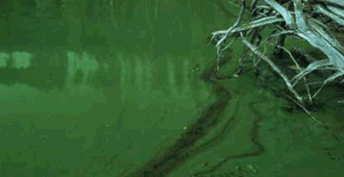
In situ R. Zurawell
Some may appear as grass clippings in the water as in this picture of Aphanizomenon.
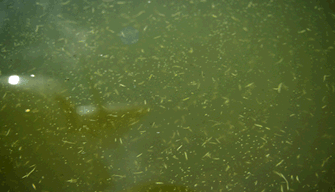
Dispersed Aphanizomenon colonies, Ron Zurawell
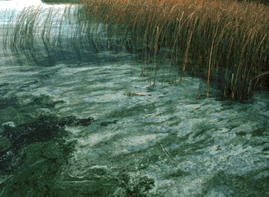
Decaying Aphanizomenon bloom, R. Zurawell
A light blue paint color is seen in this picture of Anabaena
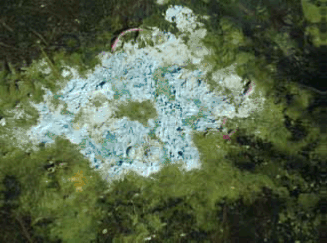
In situ: S. Murrell
An example of a growth that may look like cyanobacteria and is also potentially toxic is Euglena. Euglena can have a bright lime green color or can also turn red to protect itself if the sunlight is too intense.
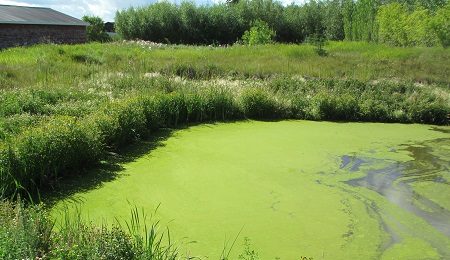
In situ: S. Elgert
Treatment
Not all toxic cyanobacteria species are susceptible to copper treatment therefore diagnosis is an important step before treatment. Most strains however can be treated with a registered product of which copper is the active ingredient. Copper treatment should be restricted as a treatment for growths in general unless necessary, such as the presence of cyanobacteria, as it is toxic to aquatic life.
After treatment of the dugout with the copper product, the cells burst open releasing all the toxins at once potentially creating a high concentration of toxins. These toxins may remain viable in the water for up to a month therefore it is important to remove the cattle from this water source during that time. Once the cyanobacteria have been killed the dead cells provide nutrients for another cycle of growth to reoccur. Therefore it is important to monitor the dugout after treatment is administered.
Copper products are not to be applied where the water may overflow and enter a public stream. Some copper products are not registered for farm dugout usage so check the registration number and contact the Pest Management Regulatory Agency to determine if particular products are appropriate for your situation.
Timing of treatments should be done to maximize their chances of success. For instance, avoid doing an in-dugout treatment just before an anticipated runoff event. Runoff that washes a new load of contaminants into the dugout may nullify the first treatment and create conditions that require yet another treatment. Keeping a record of all dugout treatments and observation of their effect is a good practice.
Copper products can be diluted and sprayed out evenly over the dugout however the correct amount for the dugout size must be predetermined. Spot spraying can reduce the amount of copper used.
A fairly inexpensive and simple preventative treatment can be done by adding a blue dye to the dugout to prevent photosynthesis, a principle component of cell growth. If you add the dye in early spring, it can help prevent initial stages of growth.
If you suspect cyanobacterial growth in your dugout that is used for animal consumption:
- Contact an Agricultural Water Specialist as soon as possible to determine if your cattle need to be removed from the source so treatment can be done.
- Provide an alternate source of drinking water for your livestock or pets if cyanobacteria are in your dugout until diagnosis is determined and the problem resolved.
- Proper identification of the algae must be made, and treatment recommendations must be provided by a Water Specialist so as not to cause harm to livestock or pets. Water analysis may be required.
- Cyanobacterial growths can lead to fish kills.
Additional Information:
- Toxins may remain in the water for up to a month after the death or treatment of the algae.
- Cyanobacterial blooms may not always be apparent as they may sink down into the water column at times.
- Do not irrigate or rinse edible crops with water that is suspected to have cyanobacteria in it, especially spray irrigated salad, leafy vegetables or strawberries.
- Laboratories for testing may be found in the Yellow Pages
- Cyanobacteria can plug emitters used for spraying crops, as well as clog filters.
- Remember to use safe practices when inspecting water sources, such as a rope tied to the edge with a floatation device and another person present.
Contacts for water source professionals
Alberta Agriculture and Forestry: 310- FARM (310-3276) – then ask for a Water Specialist
Pest Management Regulatory Agency and information:
Pesticide and Pest Management
Pest Management Regulatory Agency
Prepared by: Shawn Elgert – Agricultural Water Engineer |
|